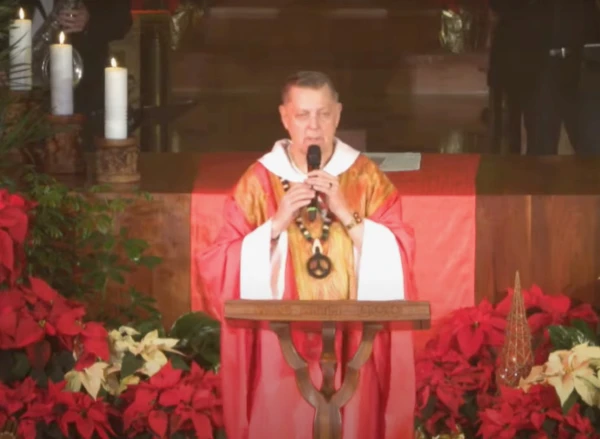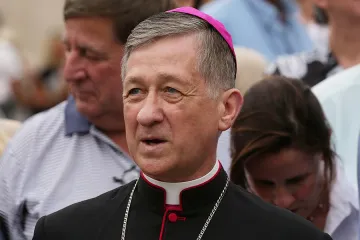Washington, D.C. Newsroom, Dec 30, 2021 / 13:28 pm
Outraged by a freewheeling Christmas Eve Mass that featured jazz musicians, choreographed dances around the altar, and theatrical lighting effects, some Catholics are calling on Cardinal Blase Cupich to crack down on liturgical abuses in Novus Ordo Masses in the Archdiocese of Chicago, rather than imposing severe restrictions on reverential Traditional Latin Masses.
Father Michael L. Pfleger, a well-known social activist in Chicago, celebrated the Dec. 24 evening Mass, which was live streamed from St. Sabina Church, a predominantly Black parish on the city’s South Side. Pfleger has been the pastor there since 1981.
Many of those upset by the Mass say it crossed the line from worship to entertainment. That view is fueled, in part, by the fact that it is not clear from the nearly 2½ hour video of the service, billed as "Christmas Eve at Sabina," when the liturgy actually begins. There is no apparent greeting, penitential act, or opening prayer, all required Introductory Rites of the Novus Ordo liturgy.
In the video, posted on YouTube, Pfleger does not appear on the altar until after nearly an hour of musical and dance performances. A band plays a mix of religious carols and secular music, including Stevie Wonder’s “Overjoyed” and the Vincent Guaraldi Trio’s “Christmas Time is Here” (best known from the Peanuts Christmas special, “A Charlie Brown Christmas”) while colorfully costumed dancers swirl around the altar.
In one of the video’s most jarring segments, prior to Pfleger’s arrival, a woman reads a reflection on racism, gun violence, and other social ills. The woman shouts at some points, while figures near the altar, including some dressed in hooded cloaks that resemble Ku Klux Klan robes, dramatize her words. (You can watch the segment at the 38:00 mark in the video below.)
“‘The people who walk in darkness have seen a great light.’ But have we? We look around and all our eyes can see is destruction and chaos, division, and even death. … Hate is sweeping across the nation in ways like we've never seen before. Racism has become just as natural as the air we breathe.”
Flashing lights and the loud beeping of a heart monitor sound effect add to the bleak litany of evils, which nevertheless ends on a positive note: “Heaven has heard your cry and responded by sending Jesus, the Light of the World, to renew your strength. Emmanuel, God is with you.”
During his homily, Pfleger, wearing a peace sign dangling from a beaded necklace, urges members of the congregation to lift up their illuminated cell phones in the darkened church, as is often done at concerts.
“It’s Christmas. It’s Christmas. Jesus, the Light of the World, is with us,” he says. “Now go turn on the damn light and curse the darkness! Come on, wave your lights! Wave your lights!” (You can watch Pfleger’s homily at the 1:26:00 mark in the video above.)
Lightning rod for controversy
Pfleger, 72, has been a prominent anti-violence and social justice advocate for many years. A Chicago native, he has been outspoken against the epidemic of gun violence in the city’s South Side and oversees a host of active social ministries at St. Sabina’s.
Volunteers from the parish planned to distribute nearly 1,000 meals at homeless shelters in the city on Christmas Day. On Jan. 1 Pfleger will lead a parish “Peace Walk” commemorating the lives lost to gun violence in the area this year and calling for more government action to stop the bloodshed.
Pfleger adopted an 8-year-old boy in 1981 and another son in 1992. In 1997 he became the foster father of another city youth who was killed in a gang shootout in 1998.
The popular priest also has been a lightning rod for controversy.
In 2008, the late Cardinal Francis George asked Pfleger to go on a two-week leave of absence after he publicly mocked then-Sen. Hillary Clinton, Barack Obama’s rival in the Democratic presidential primaries that year.
(Story continues below)
George suspended Pfleger in 2011 after the priest threatened to leave the priesthood if George reassigned him. The cardinal later accepted Pfleger’s apology and reinstated him as St. Sabina’s pastor.
In 2019, Pfleger ran into more trouble, this time with Cupich, who publicly denounced Pfleger’s decision to invite controversial Nation of Islam leader Louis Farrakhan to speak at St. Sabina.
More recently, Pfleger was removed from ministry at St. Sabina on Jan. 5, after a man came forward and alleged that he was abused by Pfleger as a child more than 40 years ago. Two other men, including one who is the brother of the first accuser, later alleged that Pfleger had abused them, also. Pfleger denied the accusations.
Cupich reinstated Pfleger in May, stating that the archdiocese’s review board “has concluded that there is insufficient reason to suspect Father Pfleger is guilty of these allegations.”

Contacted by CNA, Pfleger declined to answer questions about the Christmas Eve liturgy.
“These are some of the same people that attack Pope Francis and Cardinal Cupich and have ignored the gift and value of Black Catholicism in the Catholic Church, so I am not responding to their attacks,” Pfleger said in an email.
The Archdiocese of Chicago did not respond to a request for comment prior to publication.
Critics cite Latin Mass restrictions
Criticism of the Christmas Eve Mass comes months after similar complaints were raised in response to a pair of controversies in the archdiocese this summer.
In August, Chicago Mayor Lori Lightfoot, a non-Catholic who is in a same-sex marriage, received Communion from a city police chaplain at a funeral Mass Cupich celebrated for slain police officer Ella French. The chaplain said he made a mistake and publicly apologized.
Just days later, a Chicago pastor said he consulted with Cupich prior to prohibiting the public recitation of the Prayer to St. Michael and the Hail Mary after Masses, claiming the public prayers, which take less than a minute to recite, can distract those wishing to pray privately in the church.
Criticism of St. Sabina’s Christmas Eve Mass gained steam on social media earlier this week, after the archdiocese issued a new policy that sharply curtails the celebration of the Traditional Latin Mass and the use of liturgical texts that predate the liturgical reforms of Vatican II for other sacraments.
Under the policy, Masses using the old rite cannot be celebrated on the first Sunday of the month, Christmas, the Triduum, Easter Sunday, and Pentecost Sunday. Additionally, priests cannot celebrate Traditional Latin Masses in parish churches without permission from both the archbishop and the Vatican.
“If the Bishop really cares about his faithful,” one commenter on YouTube wrote, “he’d put a stop to this abomination, not the Latin Mass.”
“I’m a former evangelical Protestant, who is now Catholic, and this service reminds me so much of the ones that I once attended as an evangelical Protestant for many years,” another post reads. “I’m both shocked and horrified that this claims to be Catholic, Lord have mercy! No focus on the Blessed Sacrament at all.”
“The Latin Mass? No. This? Yes,” conservative Catholic commentator Taylor Marshall said sarcastically in a Dec. 29 podcast live streamed on YouTube. “It’s not fair.”
Focus should be on the Eucharist
The archdiocese’s new policy on the Traditional Latin Mass comes in response to Pope Francis’ motu proprio Traditiones custodes, released July 16, and a related explanatory document the Vatican published Dec. 18. Together, those documents place strict curbs on the use of Latin liturgical texts that pre-date Vatican II, which a small minority of Catholics still prefer.
The pope lamented the prevalence of liturgical abuses in a letter accompanying his motu proprio.
“I am saddened by abuses in the celebration of the liturgy on all sides,” he wrote in the letter. “In common with Benedict XVI, I deplore the fact that ‘in many places the prescriptions of the new Missal are not observed in celebration, but indeed come to be interpreted as an authorization for or even a requirement of creativity, which leads to almost unbearable distortions.’”
A leading Catholic liturgist contacted by CNA said he was reminded of the pope’s words while he was viewing the video of St. Sabina’s Christmas Eve Mass.
“Many of the abuses in the celebration of the Mass come from a wrong understanding of the nature and good of the Eucharistic celebration, and particularly from a distorted application of the concept of active participation in the liturgy,” Father Daniel Cardó, Benedict XVI Chair of Liturgical Studies at St. John Vianney Theological Seminary in Denver, observed in a written commentary he shared with CNA.
“The Second Vatican Council called the Church to promote a ‘full, conscious and active participation in liturgical celebrations.’ (Sacrosanctum Concilium, 14). The irony is that when activities foreign to the liturgical celebrations are inserted in the Mass, actual participation does not grow — most people remain spectators of dances or other cultural expressions, which cannot be performed by everyone,” he continued.
“The dances, songs, speeches, and light effects show a lively celebration of a Christian community, but not the Eucharist as described and celebrated uninterruptedly since the beginnings, as already perceived in the passage of the disciples going to Emmaus (Lk 24:13-35) or in the descriptions of St. Justin (mid-second century),” Cardó observed.
“What the Church wants for everyone is participation in the rites themselves, and for this, we have a safe path: the approved rites and rubrics of the liturgical celebrations.”
Cardó stopped short of saying that the St. Sabina liturgy was not a valid Mass, as some have alleged on social media. Pfleger uses the proper words of consecration during the Eucharistic Prayer, he noted.
Instead, Cardó said such liturgies risk overshadowing the Eucharist as the central focus of the Mass.
“When so much novelty and creativity take place in the celebration of the Mass, the community can grow in self-expression and human comfort, but might lose the ‘real presence’ of Jesus Christ, certainly less spectacular than concerts and choreographies, but the awe-inspiring power of God made man, of God becoming present in bread and wine,” he said.
“There is no greater pastoral good for the faithful than simply to allow God to come to his people through the rites of the Church. The relative good of self-expression of a given community can never be equal to the supreme good of receiving Christ himself in the Sacrament,” Cardó continued.
“Bethlehem reminds us that God chooses the simplicity of what’s hidden to the world to become present. In the same way, Jesus comes to the world at Mass through the simplicity of a few words and gestures, given to the apostles and faithfully transmitted by the Church,” he stated. “When creativity leads to abuses and distortions, then we are very far from the liturgical reform intended by the Second Vatican Council.”
CNA correspondent Joe Bukuras contributed to this story.





